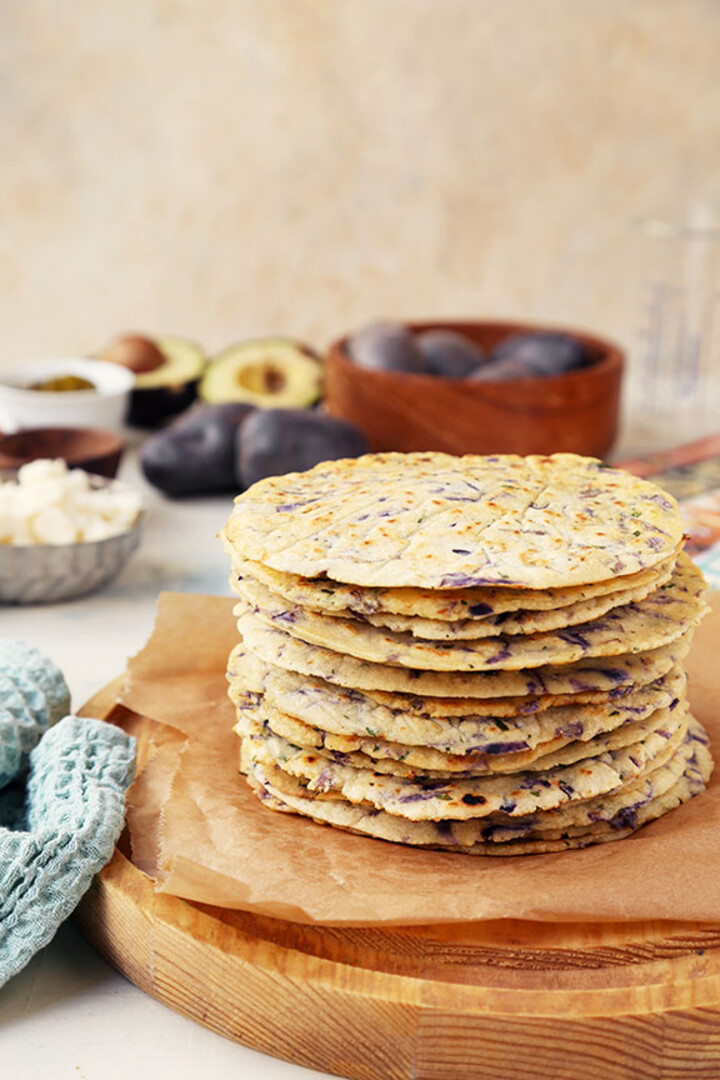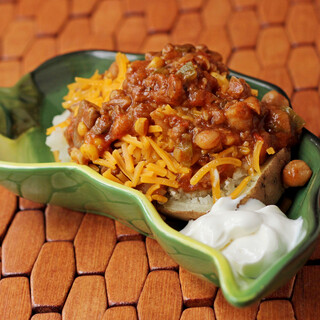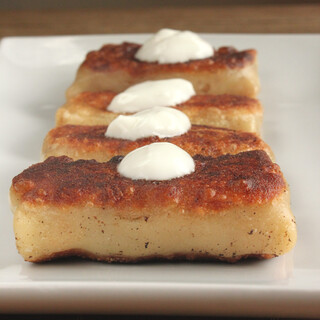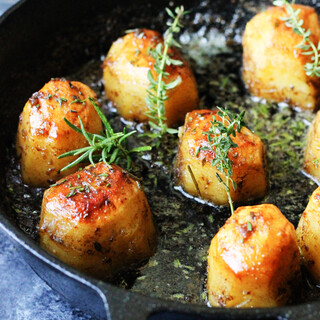Potato Tortillas
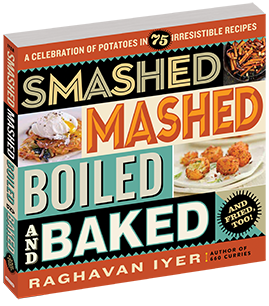 The potato, indigenous to South America, did not get to Mexico until the eighteenth century. That the Spaniards took it all the way to Europe before it made its way north is quite unimaginable. Corn tortillas, on the other hand are distinctly Mexican and Central American, but versions do exist in South America, made with the same masa. The inclusion of other flours is common in Latin America, as is altering the thickness of some of their flatbreads (think Salvadorian pupusas). The potato shreds in this recipe offer a purple landscape to a thin, pliable, and flavorful flatbread that puts any store-purchased corn tortilla to shame. And the fact that two out of the four largest crops in the world are in one recipe (corn and potatoes) is so cool in my nerdy estimation. - Raghavan Iver
The potato, indigenous to South America, did not get to Mexico until the eighteenth century. That the Spaniards took it all the way to Europe before it made its way north is quite unimaginable. Corn tortillas, on the other hand are distinctly Mexican and Central American, but versions do exist in South America, made with the same masa. The inclusion of other flours is common in Latin America, as is altering the thickness of some of their flatbreads (think Salvadorian pupusas). The potato shreds in this recipe offer a purple landscape to a thin, pliable, and flavorful flatbread that puts any store-purchased corn tortilla to shame. And the fact that two out of the four largest crops in the world are in one recipe (corn and potatoes) is so cool in my nerdy estimation. - Raghavan Iver
Jonathan made this recipe for us as part of a Cook the Book campaign for Smashed, Mashed, Boiled and Baked by Raghavan Iyer.
Ingredients:
- 8 ounces purple potatoes
- 2 cups masa harina*
- 1 teaspoon coarse sea or kosher salt
- 1/4 cup finely chopped fresh cilantro leaves and tender stems
- 1 medium-size to large habanero chile, stem discarded, finely chopped (do not remove the seeds)
- About 1½ cups hot tap water
Instructions:
- Fill a medium-size bowl with cold water. Scrub the potatoes well under running water. I like to leave the skin on since it looks pretty. Shred the potatoes through the large holes of a box grater, the fine teeth of a mandoline, or the shredding disk of a food processor. Submerge the shreds in the bowl of water to rinse off the surface starch.
- Pour the masa harina into a medium-size bowl and add the salt, cilantro, and chile.
- Drain the potatoes in a colander and rinse them under cold running water to remove any remaining excess surface starch. Give the colander a good shake or two to rid the potatoes of excess water.
- Add the potato shreds to the masa and give it all a good mix. (I use my hand.) Mix in 1 cup of the hot water. It should start to come together to form a bumpy-textured dough. Add more hot water ¼ cup at a time, making sure it gets incorporated well. The dough should feel bumpy but soft, like a textured Play-Doh, a bit grainy to the touch.
- Lay out a large sheet of wax paper or parchment paper on the counter. Wet several sheets of paper towels. Break up the dough into 16 equal portions and set them on the wax paper. Roll each portion into a ball. Keep them securely covered under wet paper towels. The moisture from them will continue to keep the dough moist.
- When you’re ready to cook the tortillas, preheat a medium-size nonstick skillet or heavy cast-iron pan over medium heat. Cut a 14-inch-square piece of parchment paper or wax paper and fold it in half. Place a dough ball inside its fold and flatten it either with a rolling pin or by pushing down on it with a pie plate. You want a circle roughly 6 inches in diameter. If you have a tortilla press, by all means, use it.
- Gently pull off the paper and place the tortilla in the hot skillet. It will start to bubble up in places and the underside should have brown patches in 3 to 4 minutes. Flip it over and cook the other side an additional 2 minutes. Transfer it to a plate and cover it with a piece of aluminum foil or a clean kitchen towel. Repeat with the remaining dough. It’s important to keep the cooked tortillas covered because the heat from within creates steam that makes them soft and pliable. Serve them warm.*
Notes:
*Look for bags of masa harina in the Latin American aisle of your supermarket. Regular cornmeal is not a substitute for this flour, as it is grainier and does not hold together as well to make a soft and cohesive dough. Masa dough is easy to work with once you understand it has a tendency to dry out very quickly. Keep the rest covered under damp paper towels as you press your individual dough rounds to make the shells. Keep a bowl of hot water around so you can wet your hand and work that moisture into the dough. As you shape the round, if it cracks around the edges, that's a telltale sign that the dough is dry. Reconstitute it by kneading in more moisture with a wet hand.
Recipe:
Chef Raghavan Iyer
Minneapolis, MN
Jonathan Melendez
Food Blogger
The Candid Appetite
